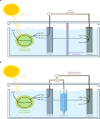The Development of Biophotovoltaic Systems for Power Generation and Biological Analysis
- PMID: 31867153
- PMCID: PMC6899825
- DOI: 10.1002/celc.201900997
The Development of Biophotovoltaic Systems for Power Generation and Biological Analysis
Abstract
Biophotovoltaic systems (BPVs) resemble microbial fuel cells, but utilise oxygenic photosynthetic microorganisms associated with an anode to generate an extracellular electrical current, which is stimulated by illumination. Study and exploitation of BPVs have come a long way over the last few decades, having benefited from several generations of electrode development and improvements in wiring schemes. Power densities of up to 0.5 W m-2 and the powering of small electrical devices such as a digital clock have been reported. Improvements in standardisation have meant that this biophotoelectrochemical phenomenon can be further exploited to address biological questions relating to the organisms. Here, we aim to provide both biologists and electrochemists with a review of the progress of BPV development with a focus on biological materials, electrode design and interfacial wiring considerations, and propose steps for driving the field forward.
Keywords: biophotoelectrochemistry; biophotovoltaics; electrode architecture; fuel cells; photosynthesis.
© 2019 The Authors. Published by Wiley-VCH Verlag GmbH & Co. KGaA.
Conflict of interest statement
The authors declare no conflict of interest.
Figures




References
-
- McCormick A. J., Bombelli P., Bradley R. W., Thorne R., Wenzel T., Howe C. J., Energy Environ. Sci. 2015, 8, 1092–1109.
-
- Haehnel W., Hochheimer H. J., Bioelectrochemistry Bioenerg. 1979, 6, 563–574.
-
- Xing D., Zuo Y., Cheng S., Regan J. M., Logan B. E., Environ. Sci. Technol. 2008, 42, 4146–4151. - PubMed
-
- Vinyard D. J., Ananyev G. M., Charles Dismukes G., Annu. Rev. Biochem. 2013, 82, 577–606. - PubMed
Publication types
Grants and funding
LinkOut - more resources
Full Text Sources
